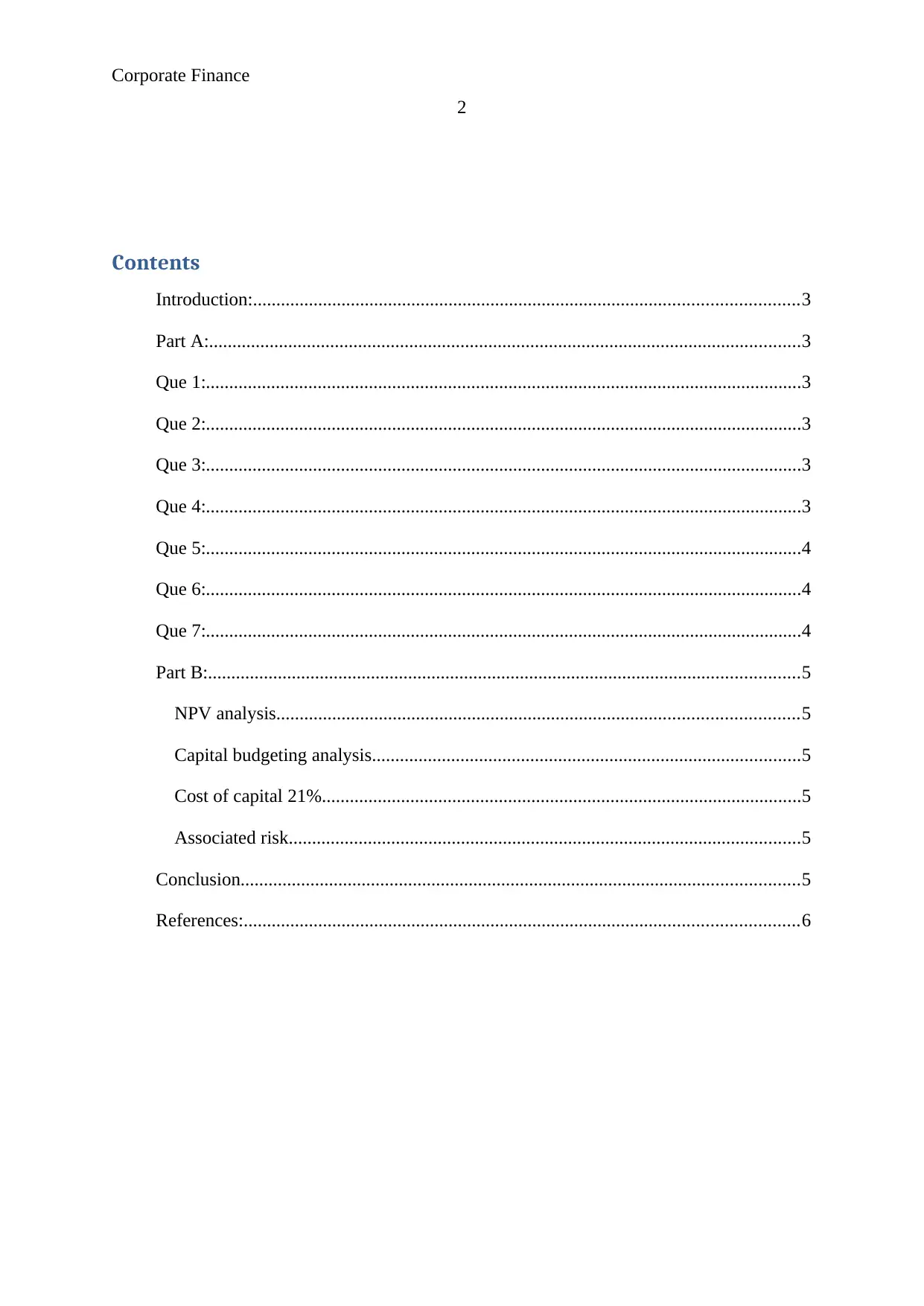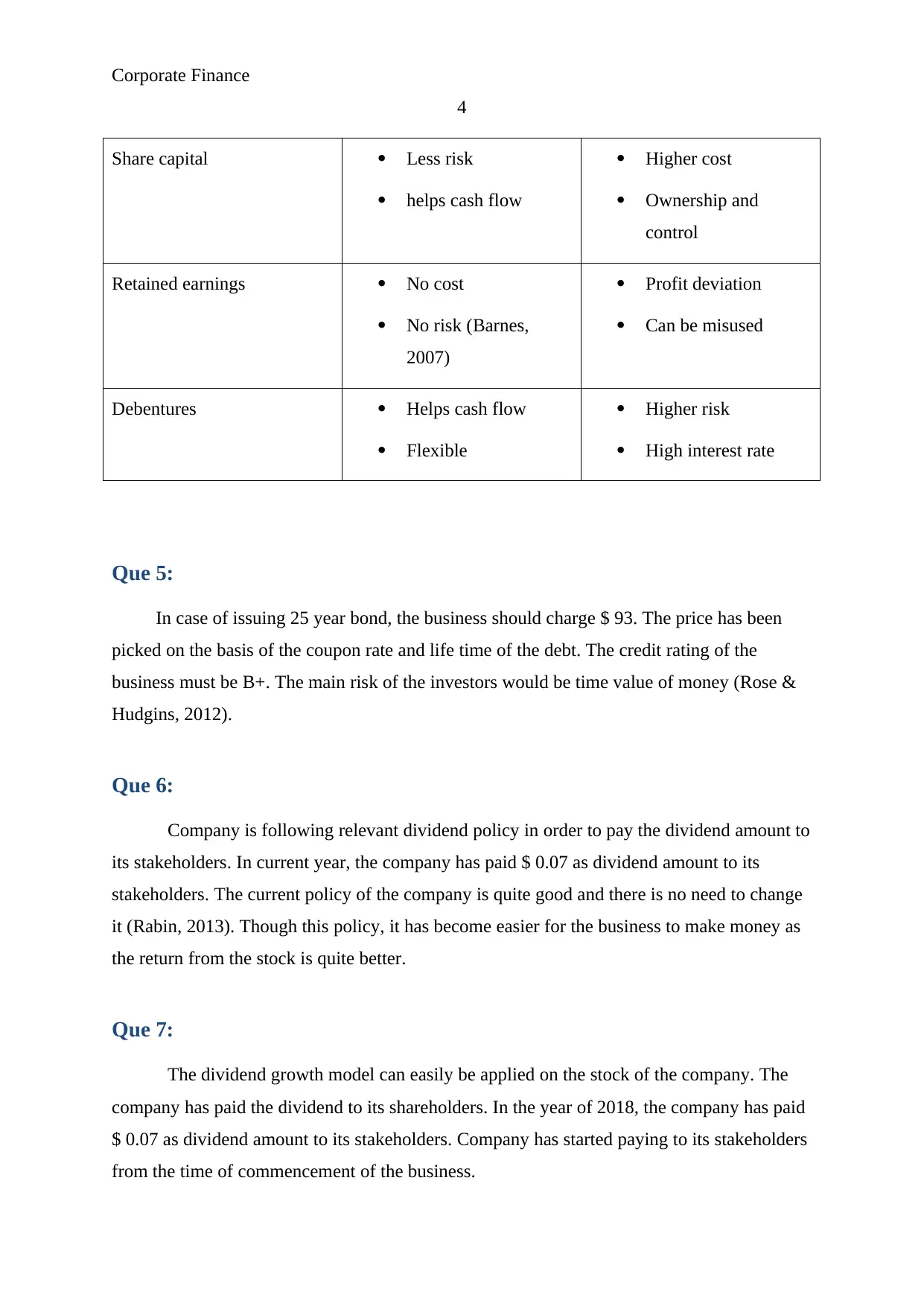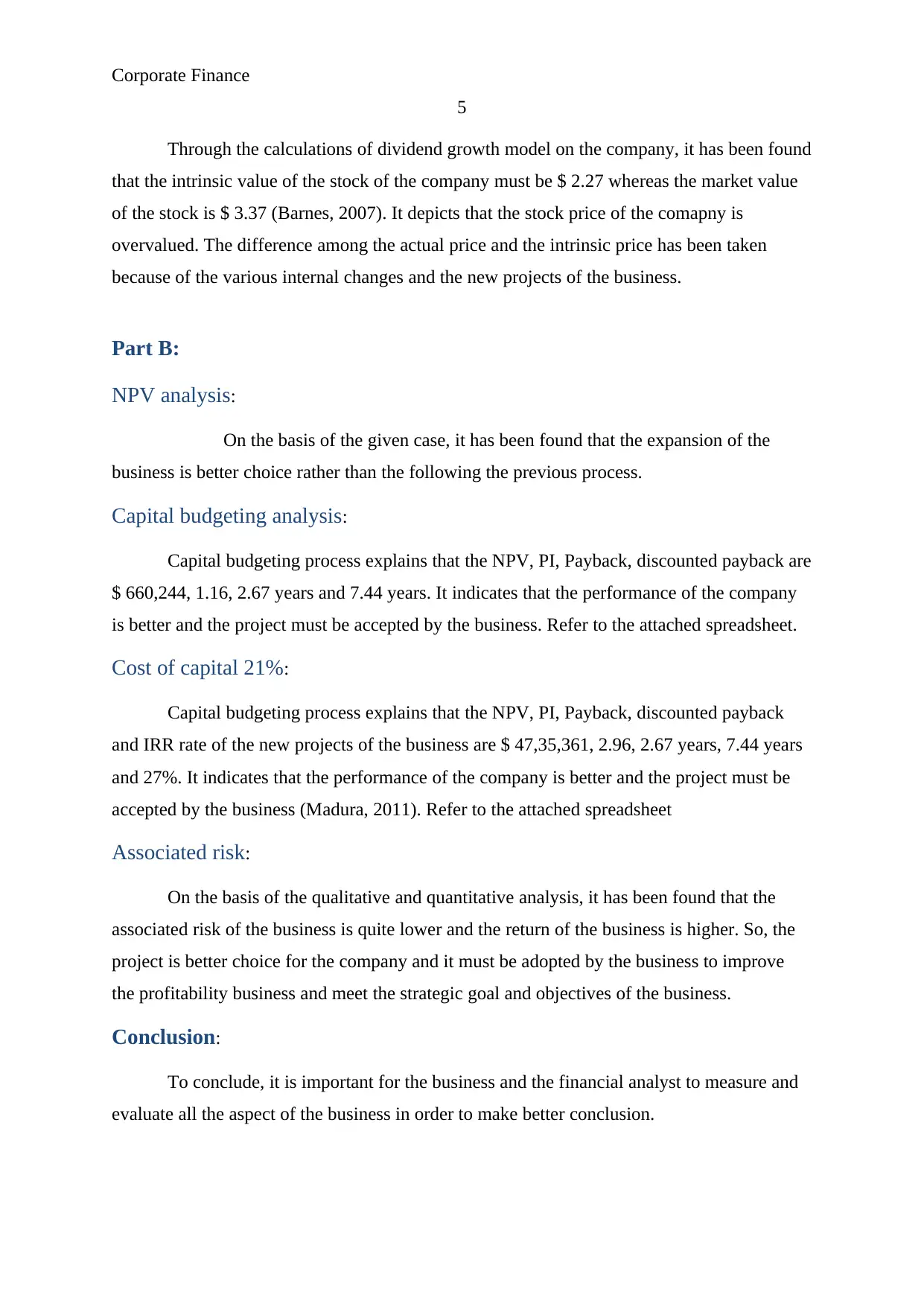Finance Project: Analysis of Waterloo Brewing Company Performance
VerifiedAdded on 2022/01/03
|6
|1069
|21
Project
AI Summary
This project report provides a comprehensive financial analysis of the Waterloo Brewing Company, focusing on its financial performance over the past two years. The report includes an examination of key financial aspects, such as suppliers and operating expenses, to identify areas for improvement. It delves into the company's finance costs, sources of long-term financing (debt, finance lease, and share equity), and the advantages and disadvantages of different financing options like share capital, retained earnings, and debentures. The project further analyzes the pricing of a 25-year bond, the company's dividend policy, and applies the dividend growth model to assess the intrinsic value of the company's stock. Part B of the report includes NPV and capital budgeting analyses, assessing the expansion of the business and its associated risks, and provides a detailed evaluation of the capital budgeting process, including NPV, PI, Payback, discounted payback, and IRR rates for new projects. The conclusion emphasizes the importance of measuring and evaluating all aspects of the business for sound financial decision-making. The report is supported by references to financial management literature.

Running Head: Corporate Finance
1
Project report: Corporate Finance
1
Project report: Corporate Finance
Paraphrase This Document
Need a fresh take? Get an instant paraphrase of this document with our AI Paraphraser

Corporate Finance
2
Contents
Introduction:.....................................................................................................................3
Part A:...............................................................................................................................3
Que 1:................................................................................................................................3
Que 2:................................................................................................................................3
Que 3:................................................................................................................................3
Que 4:................................................................................................................................3
Que 5:................................................................................................................................4
Que 6:................................................................................................................................4
Que 7:................................................................................................................................4
Part B:...............................................................................................................................5
NPV analysis................................................................................................................5
Capital budgeting analysis............................................................................................5
Cost of capital 21%.......................................................................................................5
Associated risk..............................................................................................................5
Conclusion........................................................................................................................5
References:.......................................................................................................................6
2
Contents
Introduction:.....................................................................................................................3
Part A:...............................................................................................................................3
Que 1:................................................................................................................................3
Que 2:................................................................................................................................3
Que 3:................................................................................................................................3
Que 4:................................................................................................................................3
Que 5:................................................................................................................................4
Que 6:................................................................................................................................4
Que 7:................................................................................................................................4
Part B:...............................................................................................................................5
NPV analysis................................................................................................................5
Capital budgeting analysis............................................................................................5
Cost of capital 21%.......................................................................................................5
Associated risk..............................................................................................................5
Conclusion........................................................................................................................5
References:.......................................................................................................................6

Corporate Finance
3
Introduction:
This report majorly focuses on an organization, Waterloo Brewing Company. The
financial analysis of the company has been done through focusing on the financial statement
of last 2 years of the company. Along with that, the capital budgeting analysis has also been
done on the company.
Part A:
Que 1:
The financial analysis explains that the main focus of the business should be on the
suppliers and the operating expenses as the level of gross profit and net profit has been
reduced from the last year and the focus on these factors would improve the overall
performance of the business.
Que 2:
The annual report of the company explains that the finance cost of the company is
9.07% which would be improved in near future because of the increment in the debt
financing on a higher rate according to the market demand (Chandra, 2011).
Que 3:
The main sources of long term financing of the business are debt, finance lease and
share equity. There are no restrictions on any of these sources. The business could raise the
funds on the basis of the demand and the requirement of the business. Debt funds are raised
from the market, financial lease stands for the equipment which has been taken on lease and
the shares are the part of ownership (Higgins, 2012).
Que 4:
Sources Advantages Disadvantages
3
Introduction:
This report majorly focuses on an organization, Waterloo Brewing Company. The
financial analysis of the company has been done through focusing on the financial statement
of last 2 years of the company. Along with that, the capital budgeting analysis has also been
done on the company.
Part A:
Que 1:
The financial analysis explains that the main focus of the business should be on the
suppliers and the operating expenses as the level of gross profit and net profit has been
reduced from the last year and the focus on these factors would improve the overall
performance of the business.
Que 2:
The annual report of the company explains that the finance cost of the company is
9.07% which would be improved in near future because of the increment in the debt
financing on a higher rate according to the market demand (Chandra, 2011).
Que 3:
The main sources of long term financing of the business are debt, finance lease and
share equity. There are no restrictions on any of these sources. The business could raise the
funds on the basis of the demand and the requirement of the business. Debt funds are raised
from the market, financial lease stands for the equipment which has been taken on lease and
the shares are the part of ownership (Higgins, 2012).
Que 4:
Sources Advantages Disadvantages
⊘ This is a preview!⊘
Do you want full access?
Subscribe today to unlock all pages.

Trusted by 1+ million students worldwide

Corporate Finance
4
Share capital Less risk
helps cash flow
Higher cost
Ownership and
control
Retained earnings No cost
No risk (Barnes,
2007)
Profit deviation
Can be misused
Debentures Helps cash flow
Flexible
Higher risk
High interest rate
Que 5:
In case of issuing 25 year bond, the business should charge $ 93. The price has been
picked on the basis of the coupon rate and life time of the debt. The credit rating of the
business must be B+. The main risk of the investors would be time value of money (Rose &
Hudgins, 2012).
Que 6:
Company is following relevant dividend policy in order to pay the dividend amount to
its stakeholders. In current year, the company has paid $ 0.07 as dividend amount to its
stakeholders. The current policy of the company is quite good and there is no need to change
it (Rabin, 2013). Though this policy, it has become easier for the business to make money as
the return from the stock is quite better.
Que 7:
The dividend growth model can easily be applied on the stock of the company. The
company has paid the dividend to its shareholders. In the year of 2018, the company has paid
$ 0.07 as dividend amount to its stakeholders. Company has started paying to its stakeholders
from the time of commencement of the business.
4
Share capital Less risk
helps cash flow
Higher cost
Ownership and
control
Retained earnings No cost
No risk (Barnes,
2007)
Profit deviation
Can be misused
Debentures Helps cash flow
Flexible
Higher risk
High interest rate
Que 5:
In case of issuing 25 year bond, the business should charge $ 93. The price has been
picked on the basis of the coupon rate and life time of the debt. The credit rating of the
business must be B+. The main risk of the investors would be time value of money (Rose &
Hudgins, 2012).
Que 6:
Company is following relevant dividend policy in order to pay the dividend amount to
its stakeholders. In current year, the company has paid $ 0.07 as dividend amount to its
stakeholders. The current policy of the company is quite good and there is no need to change
it (Rabin, 2013). Though this policy, it has become easier for the business to make money as
the return from the stock is quite better.
Que 7:
The dividend growth model can easily be applied on the stock of the company. The
company has paid the dividend to its shareholders. In the year of 2018, the company has paid
$ 0.07 as dividend amount to its stakeholders. Company has started paying to its stakeholders
from the time of commencement of the business.
Paraphrase This Document
Need a fresh take? Get an instant paraphrase of this document with our AI Paraphraser

Corporate Finance
5
Through the calculations of dividend growth model on the company, it has been found
that the intrinsic value of the stock of the company must be $ 2.27 whereas the market value
of the stock is $ 3.37 (Barnes, 2007). It depicts that the stock price of the comapny is
overvalued. The difference among the actual price and the intrinsic price has been taken
because of the various internal changes and the new projects of the business.
Part B:
NPV analysis:
On the basis of the given case, it has been found that the expansion of the
business is better choice rather than the following the previous process.
Capital budgeting analysis:
Capital budgeting process explains that the NPV, PI, Payback, discounted payback are
$ 660,244, 1.16, 2.67 years and 7.44 years. It indicates that the performance of the company
is better and the project must be accepted by the business. Refer to the attached spreadsheet.
Cost of capital 21%:
Capital budgeting process explains that the NPV, PI, Payback, discounted payback
and IRR rate of the new projects of the business are $ 47,35,361, 2.96, 2.67 years, 7.44 years
and 27%. It indicates that the performance of the company is better and the project must be
accepted by the business (Madura, 2011). Refer to the attached spreadsheet
Associated risk:
On the basis of the qualitative and quantitative analysis, it has been found that the
associated risk of the business is quite lower and the return of the business is higher. So, the
project is better choice for the company and it must be adopted by the business to improve
the profitability business and meet the strategic goal and objectives of the business.
Conclusion:
To conclude, it is important for the business and the financial analyst to measure and
evaluate all the aspect of the business in order to make better conclusion.
5
Through the calculations of dividend growth model on the company, it has been found
that the intrinsic value of the stock of the company must be $ 2.27 whereas the market value
of the stock is $ 3.37 (Barnes, 2007). It depicts that the stock price of the comapny is
overvalued. The difference among the actual price and the intrinsic price has been taken
because of the various internal changes and the new projects of the business.
Part B:
NPV analysis:
On the basis of the given case, it has been found that the expansion of the
business is better choice rather than the following the previous process.
Capital budgeting analysis:
Capital budgeting process explains that the NPV, PI, Payback, discounted payback are
$ 660,244, 1.16, 2.67 years and 7.44 years. It indicates that the performance of the company
is better and the project must be accepted by the business. Refer to the attached spreadsheet.
Cost of capital 21%:
Capital budgeting process explains that the NPV, PI, Payback, discounted payback
and IRR rate of the new projects of the business are $ 47,35,361, 2.96, 2.67 years, 7.44 years
and 27%. It indicates that the performance of the company is better and the project must be
accepted by the business (Madura, 2011). Refer to the attached spreadsheet
Associated risk:
On the basis of the qualitative and quantitative analysis, it has been found that the
associated risk of the business is quite lower and the return of the business is higher. So, the
project is better choice for the company and it must be adopted by the business to improve
the profitability business and meet the strategic goal and objectives of the business.
Conclusion:
To conclude, it is important for the business and the financial analyst to measure and
evaluate all the aspect of the business in order to make better conclusion.

Corporate Finance
6
References:
Barnes, P. (2007), The Analysis and Use of Financial Ratios: A Review Article, Journal of
Business Finance & Accounting, 14 (4), p. 449-461
Chandra, P. (2011). Financial management. Tata McGraw-Hill Education.
Higgins, R. C. (2012). Analysis for marketing management. McGraw-Hill/Irwin.
Madura, J. (2011). International financial management. Cengage Learning.
Rabin, M. (2013). Risk aversion and expected-utility theory: A calibration theorem.
In Handbook of the Fundamentals of Financial Decision Making: Part I (pp. 241-252).
Rose, P. S., & Hudgins, S. C. (2012). Bank management & financial services. McGraw-Hill
Education.
6
References:
Barnes, P. (2007), The Analysis and Use of Financial Ratios: A Review Article, Journal of
Business Finance & Accounting, 14 (4), p. 449-461
Chandra, P. (2011). Financial management. Tata McGraw-Hill Education.
Higgins, R. C. (2012). Analysis for marketing management. McGraw-Hill/Irwin.
Madura, J. (2011). International financial management. Cengage Learning.
Rabin, M. (2013). Risk aversion and expected-utility theory: A calibration theorem.
In Handbook of the Fundamentals of Financial Decision Making: Part I (pp. 241-252).
Rose, P. S., & Hudgins, S. C. (2012). Bank management & financial services. McGraw-Hill
Education.
⊘ This is a preview!⊘
Do you want full access?
Subscribe today to unlock all pages.

Trusted by 1+ million students worldwide
1 out of 6
Related Documents
Your All-in-One AI-Powered Toolkit for Academic Success.
+13062052269
info@desklib.com
Available 24*7 on WhatsApp / Email
![[object Object]](/_next/static/media/star-bottom.7253800d.svg)
Unlock your academic potential
Copyright © 2020–2025 A2Z Services. All Rights Reserved. Developed and managed by ZUCOL.





